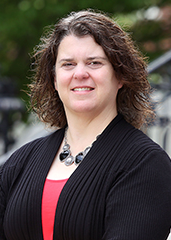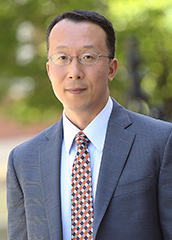Team-based learning in a foundational course
October 4, 2021
This post is republished from Into Practice, a biweekly communication of Harvard’s Office of the Vice Provost for Advances in Learning

 Carrie Conaway, Senior Lecturer, and James Kim, Professor of Education, teach the Harvard Graduate School of Education’s new foundational course, Evidence. The course trains students to understand and apply a variety of evidence to a real-life problem of practice. In order to learn about different types of evidence and how to apply it to solve real-world problems, students work in small teams using team-based learning (TBL). Conaway and Kim use survey data to construct teams that are diverse in terms of background, program, and comfort with different types of evidence. Each group activity is centered around a different component of a case developed from Kim’s research. The activities culminate in final recommendations for how to improve literacy outcomes for Charlotte-Mecklenburg Schools in North Carolina.
Carrie Conaway, Senior Lecturer, and James Kim, Professor of Education, teach the Harvard Graduate School of Education’s new foundational course, Evidence. The course trains students to understand and apply a variety of evidence to a real-life problem of practice. In order to learn about different types of evidence and how to apply it to solve real-world problems, students work in small teams using team-based learning (TBL). Conaway and Kim use survey data to construct teams that are diverse in terms of background, program, and comfort with different types of evidence. Each group activity is centered around a different component of a case developed from Kim’s research. The activities culminate in final recommendations for how to improve literacy outcomes for Charlotte-Mecklenburg Schools in North Carolina.
The benefits: By the end of the course, 100% of the students reported familiarity with every type of evidence the course covered, and students improved substantially in their ability to accurately interpret different forms of evidence. Moreover, students formed incredibly tight bonds with the rest of their team. “These relationships are things that really last,” Conaway reflects. “I’m curious to see if people look back and say, ‘Actually this was a formative moment in my social experience of the Ed School, as well as my academic experience.’” The course also creates an important jumping-off point for students professionally, training them to apply their learning across a variety of settings while practicing that application in real-time. Some students applied TBL to their own teaching, including their middle- and high-school classrooms, creating a ripple effect for the whole course.
“As faculty of higher education, we have to think more about how we can use innovative, active learning pedagogies where students do most of the thinking.”
The challenges: One of the key challenges is getting students used to the vocabulary. “We know from research on language acquisition that kids need multiple encounters with a word in a variety of contexts for it to stick,” Kim explains. “And it’s not that different in higher education.” Applying this research, they highlight several key terms of evidence each class and encourage students to use them in discussion. This was helpful not only for each student’s individual understanding of the vocabulary, but also for the team’s collective use—to be able to reference and apply terms about evidence from a shared definition.
Takeaways and best practices
- Take time to prepare in advance. Prior to each class, students watch video lectures and then take short quizzes individually to assess their own learning. Then in class, the first thing students do is retake the quiz as a team, in a shortened version that focuses on the most important and most frequently misunderstood questions. On top of that, Conaway stresses the importance of using authentic examples that push students to work through core concepts in an applied way. All of this takes time, but both professors emphasize how essential and worthwhile it is for students to truly understand and to use the core concepts outside the classroom.
- Model teamwork within the teaching team. Conaway and Kim work to foster a team-based environment not only between student teams, but across the entire classroom. “We try to model for the students that we are a team,” Kim explains. “Carrie and I are a team of instructors, and we are not going to call you ‘students.’ We’re going to call you ‘evidence colleagues.’” Their partnership offers students an example for structuring their own collaborations and strengthens their learning. “We felt the back-and-forth between us models for them different perspectives and different ways of interpreting it,” Conaway adds. It also better simulates most professional settings, allowing students to practice developing skills surrounding evidence in a collaborative environment.
- Build activities with simple tasks that require complex thinking. Projects like a “group essay” or “group project” can offer an overly complex task. TBL instead asks students to make a yes/no decision, where “it’s like a jury trial. The person is innocent or guilty, but to arrive at that, the jury must go through a lot of complex evidence. But the task itself is very simple.” This overall structure (combined with the quizzes) strengthens accountability, alleviates the “free-rider” problem, and significantly enhances students’ learning. “When you’re in teams, it’s as if you’re peer-reviewing your ideas and dealing with your own confirmation biases as you listen to your colleagues.”
Bottom line: For faculty interested in applying TBL into their classrooms, Conaway and Kim advise taking things slowly and incorporating it little by little over time. “Don’t feel like you have to TBL your entire course. TBL one day, one week.” “We take little baby steps – heroic incrementalism to get to where we want to be.” Conaway recommends grounding TBL in one’s own research and experience. “We decided to do one thing we knew we could do well,” Conaway explains about their choice to focus on K-12 literacy, Kim’s research expertise. This helps strengthen the types of applied cases one can construct, she notes, and generates a solid framework that can eventually be applied to other topics.

